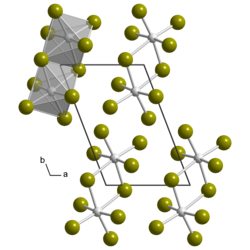 | |
| Identifiers | |
|---|---|
3D model (JSmol) | |
| ChemSpider | |
PubChem CID | |
CompTox Dashboard (EPA) | |
| |
| |
| Properties | |
| UBr5 | |
| Molar mass | 637.549 g/mol |
| Appearance | dark brown, hygroscopic crystalline solid |
| decomposes | |
Except where otherwise noted, data are given for materials in their standard state (at 25 °C [77 °F], 100 kPa). | |
Uranium pentabromide is an inorganic chemical compound with the formula U2Br10.